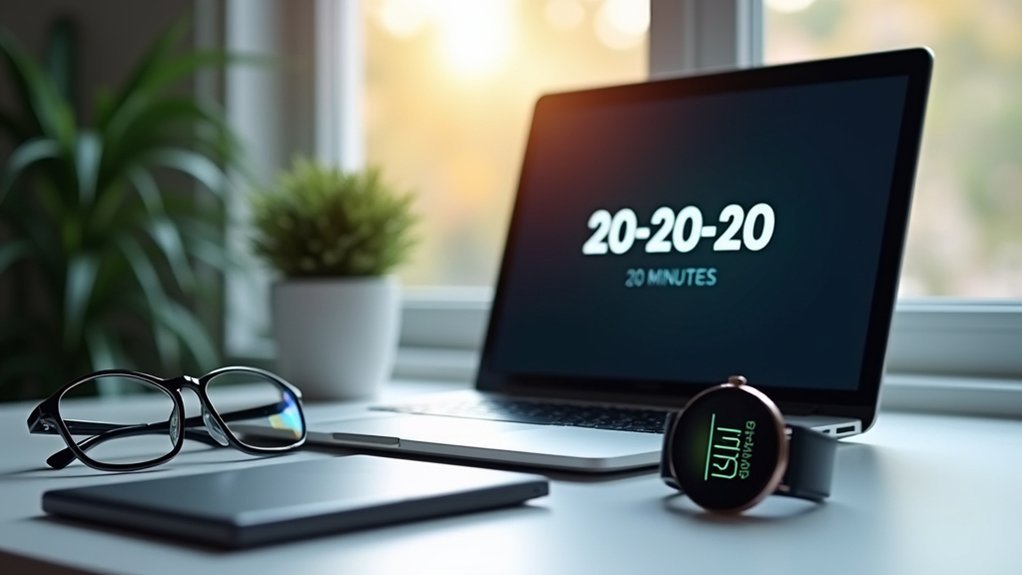You’re coding for hours, and suddenly your eyes feel like sandpaper—a common scenario for digital professionals. The persistent discomfort of prolonged screen exposure isn’t just an inconvenience; it’s a physiological response your body’s signaling. Digital eye strain can dramatically impact your workplace performance and long-term visual health. What if a simple, scientifically-backed technique could mitigate these symptoms and enhance your productivity? The 20-20-20 rule offers a precise, actionable solution that’s garnering attention in ergonomic and occupational health circles.
Key Takeaways
- The 20-20-20 rule involves taking a 20-second break every 20 minutes to look at an object 20 feet away, reducing digital eye strain and visual fatigue.
- Regular eye breaks help relax eye muscles, minimize focusing stress, and prevent symptoms like blurred vision, headaches, and light sensitivity during prolonged screen use.
- Implementing the rule supports workplace productivity by providing short, strategic interruptions that refresh visual focus and reduce accumulated eye muscle tension.
- Digital apps and timers can assist in consistently practicing the 20-20-20 rule, making eye health breaks more structured and easier to remember.
- Beyond screen breaks, supplementing the 20-20-20 rule with proper ergonomics, screen brightness adjustments, and occasional physical movement enhances overall visual comfort and performance.
Understanding Digital Eye Strain

While digital devices have become integral to modern life, their prolonged use can lead to a significant health concern known as digital eye strain (DES). You’re likely experiencing eye discomfort if you spend extended periods staring at screens, which can manifest as blurred vision, headaches, and light sensitivity. The increasing reliance on digital technology across work and leisure contexts has amplified the prevalence of DES among individuals of all ages.
Proper ergonomics and strategic screen time management are essential for mitigating these symptoms. The 20/20/20 rule emerges as a potential intervention, encouraging users to pause every 20 minutes and focus on an object 20 feet away for 20 seconds. This approach aims to reduce eye strain and support overall eye health during prolonged digital device usage.
What Is the 20-20-20 Rule?

Screen fatigue has become a common modern ailment, and the 20-20-20 rule offers a strategic intervention for digital eye strain. This evidence-based eye care technique involves taking a deliberate 20-second break every 20 minutes, during which you shift your gaze to an object positioned 20 feet away. Proposed by Dr. Jeffrey Anshel in the late 1990s, the rule aims to relax eye muscles and mitigate the physiological stress induced by prolonged computer use and digital device engagement.
While scientific research hasn’t conclusively demonstrated its extensive effectiveness, the 20-20-20 rule provides a practical method for interrupting continuous near-focus activities. By implementing these brief, intentional breaks, you can potentially reduce eye strain symptoms and maintain better visual comfort during extended screen interactions.
The Science Behind Eye Breaks

Because prolonged digital device use can trigger complex physiological responses in the human visual system, understanding the neurological mechanisms underlying eye strain becomes essential. The 20/20/20 rule offers a strategic intervention for mitigating computer vision syndrome (CVS) by interrupting continuous visual focusing mechanisms. When you engage in extended screen time, your eye muscles experience repetitive tensing, which can diminish visual acuity and induce fatigue. Regular eye breaks interrupt this cycle, allowing muscular relaxation and reducing accumulated strain. While research presents mixed evidence regarding the rule’s precise efficacy, empirical observations suggest that intermittent visual repositioning can substantially alleviate digital eye stress. Implementing systematic breaks not only supports ocular health but potentially enhances overall productivity by preventing cognitive and visual exhaustion associated with prolonged digital device engagement.
How to Implement the Rule in Your Daily Routine

Many professionals find that integrating the 20/20/20 rule into their daily workflow requires strategic planning and technological assistance. Utilize digital apps like Eye Care 20 20 20 to set precise timers that prompt 20-second breaks every 20 minutes while working on digital devices. During these intervals, deliberately shift your focus to objects at least 20 feet away, leveraging windows or distant landmarks to effectively relax eye muscles and mitigate eye strain.
Enhance these breaks by incorporating hydration and physical movement. Drink water to support eye health and counteract screen-induced dryness. Engage in brief stretching or walking to improve overall productivity. By systematically implementing these strategies, you’ll develop a sustainable approach to managing visual fatigue and maintaining peak performance across digital work environments.
Technology Tools to Help You Remember

Digital fatigue’s silent nemesis lies in strategic technological interventions designed to combat eye strain. Leverage your digital devices’ built-in timer and reminder features to systematically implement the 20/20/20 rule. Smartphone and computer applications like Eye Care 20 20 20 offer customizable eye break notifications, seamlessly integrating eye health into your productivity workflow. Wearable technology extends this capability, programming alerts that prompt periodic visual respites.
Productivity techniques such as the Pomodoro Technique inherently support structured breaks, aligning with eye strain prevention strategies. By configuring these technological tools, you’ll transform potential digital health risks into proactive wellness opportunities. The key is consistent, strategic implementation of reminders that interrupt prolonged screen engagement, ultimately preserving visual comfort and maintaining cognitive performance in our increasingly digital work environments.
Additional Strategies for Eye Health
While the 20-20-20 rule serves as a foundational strategy for mitigating eye strain, extensive eye health demands a multifaceted approach. When looking at digital devices, you’ll want to implement thorough protective measures. Use a matte screen filter to reduce glare and adjust screen brightness to match ambient lighting conditions. Maintain proper ergonomics by positioning your screen at eye level, approximately 25 inches away from your eyes. Integrate frequent breaks every 20 minutes, supplementing the 20-20-20 rule with additional 5-minute distant object viewing. Consider using a humidifier to combat dry environmental conditions and regularly apply artificial eye drops to maintain ocular moisture. These strategic interventions can greatly mitigate digital eye strain, preserving visual comfort and long-term eye health during extended digital interactions.
Ergonomic Tips for Workplace Vision Care
Protecting your visual health extends beyond individual screen interactions into thorough workplace ergonomics. By implementing strategic ergonomic adjustments, you can mitigate eye strain and enhance digital screen productivity.
| Ergonomic Factor | Ideal Setting | Impact on Vision |
|---|---|---|
| Screen Distance | 25 inches | Reduces visual discomfort |
| Monitor Height | Eye level or slightly below | Minimizes neck strain |
| Seating Position | Adjustable, supportive chair | Promotes proper alignment |
| Lighting | Reduced glare, balanced illumination | Decreases digital eye strain |
Utilizing computer eyeglasses designed for intermediate distances and maintaining a consistent 20-20-20 rule can considerably reduce visual fatigue. Strategically positioning your workstation, cleaning digital screens regularly, and selecting ergonomic seating will create an environment that supports ocular health and sustained workplace performance.
When to Seek Professional Eye Care
When might eye strain signal a more serious underlying condition? Digital eye strain symptoms like persistent blurred vision, headaches, or dry eyes warrant professional eye care evaluation. If you’ve implemented the 20/20/20 rule and still experience worsening symptoms after prolonged screen use, it’s vital to consult an eye care professional.
Regular eye exams can identify uncorrected vision problems contributing to digital eye strain. Pay attention to persistent signs such as light sensitivity or eye redness, which might indicate deeper visual health concerns. Children experiencing screen-related vision difficulties should receive specialized assessment to prevent long-term complications.
Professional advice becomes essential when preventive measures fail to alleviate symptoms. Timely intervention can diagnose and address potential underlying conditions, ensuring ideal visual performance and comfort in our increasingly digital workplace environment.
Long-Term Benefits of Regular Eye Breaks
Because digital screen usage continues to increase across professional and personal domains, understanding the long-term physiological benefits of regular eye breaks becomes critical for maintaining ideal visual health. By implementing the 20/20/20 rule, you’ll systematically reduce risks associated with digital eye strain and computer vision syndrome. These strategic eye breaks optimize visual comfort by allowing eye muscles to relax and promoting natural hydration and lubrication mechanisms. Periodic focus adjustments help prevent cumulative strain, potentially mitigating future vision-related complications. Scientifically, consistent interruptions in screen engagement enable muscular recovery, decrease potential neurological stress, and support sustained cognitive performance. Your proactive approach to managing visual ergonomics through structured breaks can greatly impact long-term eye health, transforming potentially detrimental digital interactions into sustainable, vision-preserving experiences.
Frequently Asked Questions
What Is the 20 20 Rule for Eye Strain?
You’ll reduce eye strain by taking a 20-second break every 20 minutes, looking 20 feet away during screen time. This vision care technique helps minimize digital device fatigue and supports workplace ergonomics and productivity.
Does the 20/20/20 Rule Actually Work?
Only 13.1% know this rule! You’ll mitigate visual fatigue through strategic eye exercises during prolonged screen time. Implementing ergonomic adjustments and digital wellness practices can enhance eye health, reducing productivity-inhibiting strain with precise, intentional breaks.
What Is the 20 20 Eye Trick?
You’ll alleviate digital fatigue by implementing this eye care technique: every 20 minutes, pause screen time, focus 20 feet away for 20 seconds. This visual health strategy reduces workplace eye strain, enhancing productivity through strategic relaxation techniques.
What Is the 20-20-20 Protocol?
Tired of digital eye strain? The 20-20-20 protocol is a scientifically-designed eye health strategy where you pause every 20 minutes, focus 20 feet away for 20 seconds, mitigating screen-induced vision fatigue and enhancing workplace productivity through strategic work breaks.
Conclusion
You might think eye breaks interrupt workflow, but they actually enhance productivity. By systematically implementing the 20-20-20 rule, you’ll mitigate digital eye strain and maintain peak visual performance. The neurological and physiological benefits of regular ocular rest periods demonstrate a scientifically validated approach to sustaining cognitive function and reducing visual fatigue during prolonged screen engagement. Your eyes—and productivity—will thank you.

